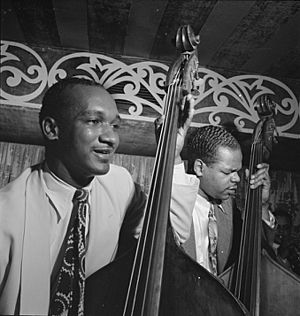Oscar Pettiford facts for kids
Quick facts for kids
Oscar Pettiford
|
|
|---|---|

Pettiford at the Aquarium, New York City, in 1946
|
|
| Background information | |
| Born | September 30, 1922 Okmulgee, Oklahoma, U.S. |
| Died | September 8, 1960 (aged 37) Copenhagen, Denmark |
| Genres | Jazz, bebop, third stream |
| Occupation(s) | Musician, composer |
| Instruments | Double bass, cello |
| Years active | 1942–1960 |
| Labels | Debut, Bethlehem, ABC |
| Associated acts | Thelonious Monk, Coleman Hawkins, Charlie Barnet, Earl Hines, Ben Webster, Dizzy Gillespie, Miles Davis, Duke Ellington, Milt Jackson, Sonny Rollins, Art Tatum, Johnny Hodges, Kenny Dorham, Woody Herman |
Oscar Pettiford was an American jazz musician. He was born on September 30, 1922, and passed away on September 8, 1960. Oscar was a talented player of the double bass and cello. He was also a composer, writing his own music. He was one of the first musicians to play in the bebop style of jazz.
Contents
Oscar Pettiford's Early Life and Music
Oscar Pettiford was born in Okmulgee, Oklahoma, in the United States. His mother was from the Choctaw people. His father, Harry "Doc" Pettiford, was half Cherokee and half African American.
Oscar grew up in a musical family. He started by singing and dancing in their family band. When he was 12, he switched to playing the piano. Then, at 14, he began playing the double bass. He once said he didn't like how others played the bass. So, he decided to create his own unique style.
Even famous musicians like Milt Hinton admired Oscar's bass playing when he was just 14. However, in 1941, Oscar almost quit music. He didn't think he could earn a living from it. But five months later, he met Hinton again, who convinced him to keep playing.
Becoming a Jazz Star
In 1942, Oscar joined the Charlie Barnet band. He became more widely known in 1943. This was after he recorded the song "The Man I Love" with Coleman Hawkins. Around this time, he also recorded music with Earl Hines and Ben Webster.
After moving to New York, Oscar became a key player in the early jazz scene. He jammed with other great musicians like Dizzy Gillespie, Thelonious Monk, and Kenny Clarke. They played at a famous club called Minton's Playhouse. This is where the new music style, later called bebop, began to develop.
In 1943, Oscar and Dizzy Gillespie even led their own bebop group. In 1945, Oscar went to California with Coleman Hawkins. He appeared in a mystery movie called The Crimson Canary. This film was famous for its jazz music. From 1945 to 1948, Oscar played with the legendary Duke Ellington. He also worked with Woody Herman in 1949. After that, he mostly led his own bands in the 1950s.
As a band leader, Oscar accidentally discovered the talented musician Cannonball Adderley. One of Oscar's musicians played a trick on him. He got Adderley, who was then an unknown music teacher, to play on stage. Oscar challenged Adderley with a difficult song. Adderley played it so well that everyone was amazed.
Pioneering the Cello in Jazz
Oscar Pettiford is known for being the first to use the cello as a solo instrument in jazz. He first played the cello as a joke on his band leader, Woody Herman. During his solo, Oscar walked off stage. He then came back with a cello and played it, surprising everyone.
In 1949, Oscar broke his arm. This made it impossible for him to play his double bass. So, a friend lent him a cello. Oscar experimented with it, tuning it like a double bass but one octave higher. This way, he could still play music even with his arm in a sling. He made his first recordings with the cello in 1950. The cello then became his second main instrument. He continued to play and record with it for the rest of his career.
Later Career and Legacy
Throughout the 1950s, Oscar recorded many albums. He worked with record labels like Debut, Bethlehem, and ABC Paramount. In the mid-1950s, he played on the first three albums that Thelonious Monk recorded for the Riverside label.
Between 1954 and 1958, Oscar Pettiford also led different groups. These included sextets (six musicians), big bands, and jazz orchestras. They performed in famous New York City venues like Birdland. Oscar loved to try out unusual combinations of instruments. He even included French horns and a harp in his orchestra. The musician and composer Gigi Gryce helped Oscar create new arrangements for these unique albums.
In 1958, Oscar Pettiford moved to Copenhagen, Denmark. There, he began recording for European music companies. After moving to Europe, he often played with European musicians like Attila Zoller. He also performed with other American musicians who had moved to Europe, such as Bud Powell and Kenny Clarke.
Oscar Pettiford passed away in 1960 in Copenhagen. He was almost 38 years old. He died from a virus similar to polio. His contributions to jazz, especially his pioneering work with the cello, left a lasting impact on music.
Discography

Here are some of the albums Oscar Pettiford recorded:
As leader
- The New Oscar Pettiford Sextet (1953)
- Oscar Pettiford (1954)
- The Oscar Pettiford Orchestra in Hi-Fi (1956)
- Winner's Circle (1957)
As sideman
Oscar also played on many albums with other famous jazz artists:
- Miles Davis: The Musings of Miles (Prestige)
- Duke Ellington: Carnegie Hall Concert January 1946 (Prestige)
- Coleman Hawkins: The Hawk Flies High (OJC, 1957)
- Milt Jackson: Plenty, Plenty Soul (Atlantic, 1957)
- Thelonious Monk: Thelonious Monk Plays Duke Ellington (Riverside, 1955)
- Sonny Rollins: Freedom Suite (Riverside, 1958)
See also
 In Spanish: Oscar Pettiford para niños
In Spanish: Oscar Pettiford para niños


